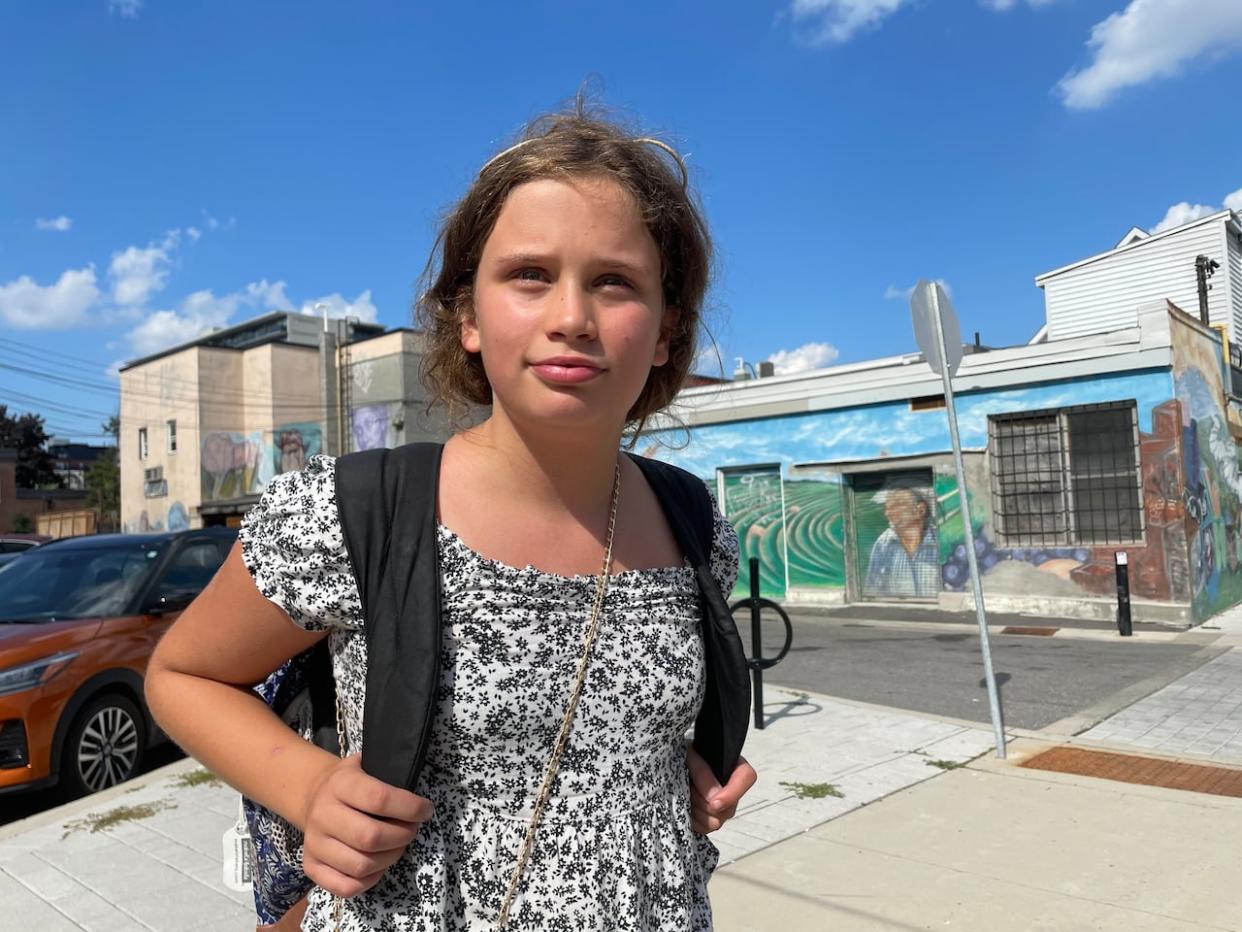Some students sweating out heat wave in sweltering schools

Sienna Rader spent her first two days of Grade 5 sweating through recess, but the heat wave didn't get her down.
"School was very great," she said. "Recess was sweltering, but I think we got through it because we have air conditioning in our class, so after recess, when you get into the classroom, it's very cool, and then you stop sweating."
She's one of the lucky ones. Her schoolmate at Elgin Street Public School, 11-year-old Sally Eves, has class in a portable. She said the air conditioner there is broken.
Eves and her friends found creative ways to endure. They made fans out of duotangs and folded-up name tags.
"It's so hot," she said. "It's hard to pay attention when it's so hot and you need to keep fanning yourself."
Students have come back to school in the midst of a heat wave that set a record for the hottest Sept. 6, according to CBC's Climate Dashboard. Some are sweating it out in older schools that lack air conditioning in the classroom.
"The vast majority of our secondary sites don't have air conditioning," said Stephanie Kirkey, who represents secondary contract teachers with the teachers' bargaining unit of the Ontario Secondary School Teachers' Federation, district 25.
The boards say it's not quite so bad. The Ottawa-Carleton District School Board (OCDSB) said about 70 per cent of its schools are either fully air conditioned or have air conditioning in the classrooms, while the Ottawa Catholic School Board (OCSB) said 53 of its 84 schools are totally air conditioned.
The Catholic board also said every portable classroom in its schools has air conditioning.
'Wasting away' in Spanish class
Spokespeople for both boards said all of their schools have at least one air-conditioned area for students to cool down, whether it's a gym, library or office.
Eves said she sought refuge in her school's library. Up the road at Lisgar Collegiate Institute, Grade 10 student Damian Janes spent his lunch hour in the food court of a nearby office building, which he called "beautifully air conditioned."
Spanish class was not so pleasant.
"I was kind of wasting away in my chair there," he said. "The last couple days, it has been pretty terrible. I couldn't give an exact temperature, but everyone's sweating. It's hard to concentrate. It's just really terrible, a terrible experience."
Kirkey, who taught for more than two decades, has noticed heat can affect student learning. Unmitigated heat waves lead to "pretty brutal and miserable" conditions in some classrooms, she said.
"It's challenging, for sure, especially to keep students motivated and focused," said Kirkey.
Teachers try to be flexible, she said, breaking up lessons and pushing back tests until cooler weather returns.
Darcy Knoll, a spokesperson for the OCDSB, said facilities department staff watch weather forecasts and modify ventilation systems "to maximize the benefit of cooler temperatures during the night." Schools may also use portable fans, he said, and the board encourages principals to come up with their own strategies to provide relief.
Students are encouraged to drink fluids, wear lightweight clothing, seek shade, wear a hat and use sunscreen where direct sun exposure cannot be avoided, according to Knoll. Strenuous outdoor exercise is also discouraged.
Rader put that same advice in her own terms.
"Don't run a lot," she said. "If you're playing a tag game, don't chase each other very [fast]. Just jog or even walk."
Some parents keep kids home
At OCSB, spokesperson Sharlene Hunter said some classes might be moved to common areas or gyms if heat becomes "problematic." Teachers might adjust schedules, including by moving outdoor activities to cooler times or giving students more water breaks.
She said parents and guardians of children with heat-related medical conditions should do what's best for their children.
"If they feel it is necessary to keep their child at home, we encourage them to do so," she said.
Laura McCullough did precisely that. Her daughter goes to John McCrae Secondary School, a public high school in Barrhaven, and got a migraine she believes was caused by hot conditions there on Tuesday.
"She had heat exhaustion … I wasn't going to have her go today in the heat," McCullough said in an interview Wednesday evening. "How much is she actually going to learn?"
She said none of her daughter's classrooms have air conditioning. The best a teacher could manage in one, a portable classroom, was to stick a fan by an open door.
Students want relief, ASAP
Eves said something should be done about the faulty air conditioner in her portable, and fast.
"It was broken for most of last year too," she said. "I feel that they should probably get it fixed pretty quickly because it's quite hot."
The provincial government said it's providing funding that should allow school boards to do just that.
Grace Lee, a spokesperson in the office of the education ministry, pointed to a roughly $600-million investment to improve air quality in schools. She said the government also provides $1.4 billion annually to boards to pay for renewing and repairing schools, and they can use that money to buy air conditioners.
Lee added that the province is now building "state-of-the-art schools" with modern ventilation, air conditioning, and "the highest standards of filtration."
The provincial NDP has called funding "stagnant" and insufficient to catch up with the province's school repair backlog.
For those left sweltering in outdated facilities, the upgrades aren't coming soon enough.
"Everybody's complaining about it," said Janes. "I think we've definitely got to get some air conditioning going, ASAP."


